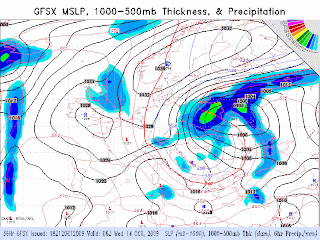 Hurricane Rick
Hurricane Rick in the Eastern Pacific is now a category 5 monster. The estimated minimum central pressure is 906 mb (26.75 inches)...maximum sustained winds estimated at 180 mph...with hurricane force winds extending out to 45 miles from the center and tropical storm force to 155 miles. Rick is the second strongest hurricane on record in the Eastern Pacific. A wider view:

And a visible image from earlier today:

Although Rick currently moving westward, a trough is forecast to dig into Southern California by Monday and turn Rick to the north. GFS has been consistent with moving Rick into Southern Baja by late Wednesday and NHC concurs:

Meanwhile, a polar airmass with dewpoints in the 30s had prompted frost advisories (in blue) and freeze warnings (light blue) across the Ohio Valley and Southeast.

Freeze warnings cover almost all of Ohio, most of Missouri, The Appalachians down to extreme Northeast Georgia, and even the County north of Tulsa, Ok. Frost advisories are in effect for most of Illinois, Indiana, Missouri, Kentucky, and Tennessee including Nashville and Chattanooga. Freeze watches (dark blue) go down to parts of Mississippi, Alabama including Birmingham, and Georgia including Atlanta and even to just two counties north of Macon. Dewpoints are now in the 30s even on the Gulf Coast.

At station
42363, about 100 miles south of New Orleans, the dewpoint fell to 42.1. I am reminded now that this same station
measured a dewpoint of 55F (12.8)C back on August 23rd. It should be noted that this is a drilling platform with measurements taken at a height of 37 meters as opposed to the more standard 4. Even so, the dewpoint at 4 meters at
station 42039 115 nautical miles southeast of Pensacola was
57 0n August 23rd and 47.7 at 1AM today - and an air temperature of only 60.4 currently. This cool airmass has swept through the entire Gulf of Mexico.

Buoy 42055 in the Bay of Campeche recorded a temperature drop of almost 7 degrees.

Even though this buoy is at 22 latitude, the front was still strong enough to produce 35 knot wind gusts and sustained winds at over 3

Also, Eureka, Canada on Ellsemere Island already hit -20 degrees on Oct. 17th. It went down to -22 at 8PM with a dewpoint of -31.
And yes, there was
even more snow in central Pennsylvania...



























































